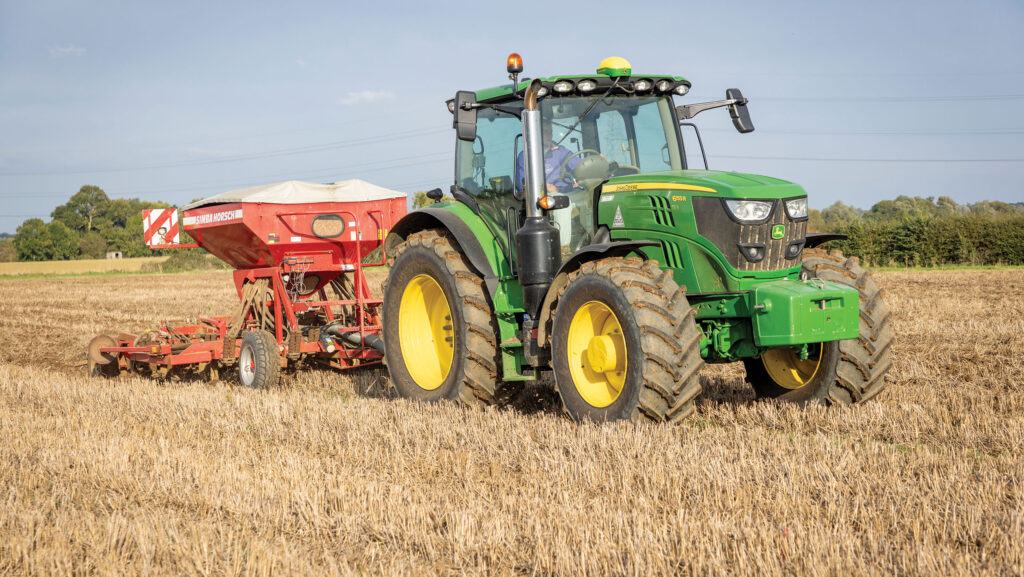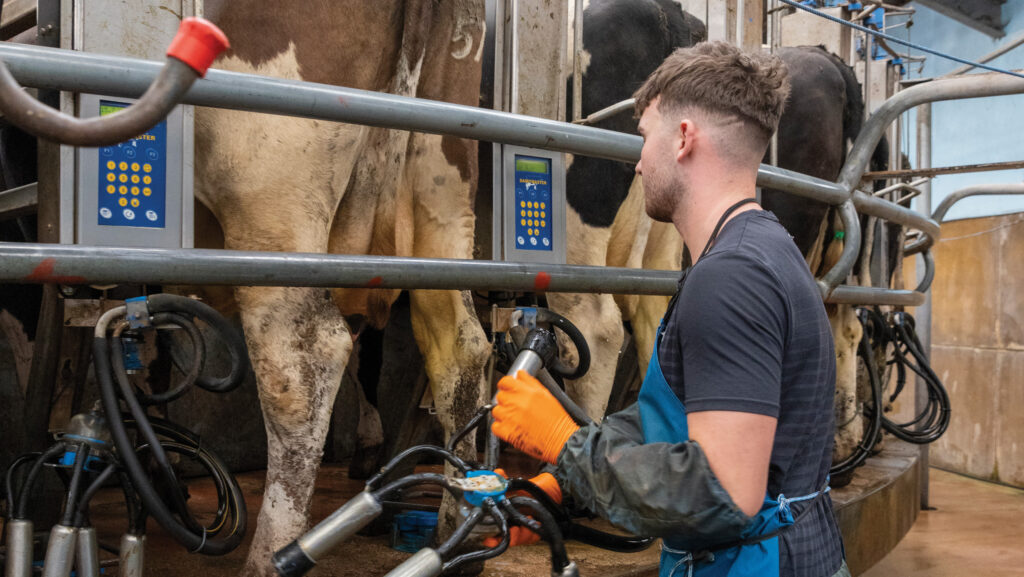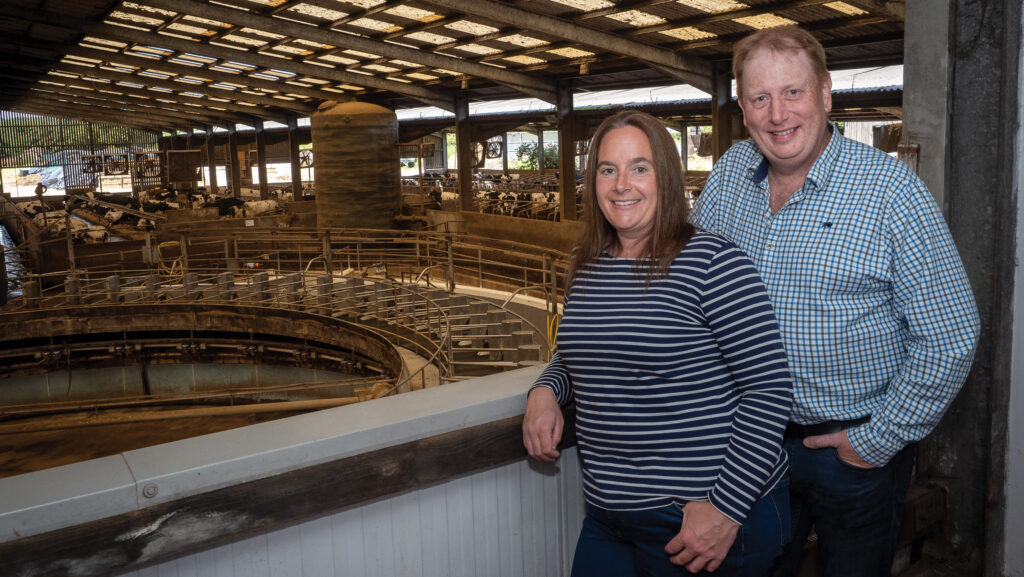How agriculture can beat the labour crisis with new recruits
 © Tim Scrivener
© Tim Scrivener Agriculture has traditionally recruited workers from within its own ranks.
But labour shortages and new farming techniques mean farmers should look beyond established recruitment sources to find the right person for the job.
We consider the barriers to taking on recruits from outside farming, look at advice for employers and hear from a farming couple on how they connect with the local community.
See also: 8 tips to help you recruit the right farm staff
Why change is needed
The reluctance to recruit from beyond farming circles was recently highlighted in a survey by The Institute for Agriculture and Horticulture (Tiah).
It found that 42% of respondents were unwilling to take on staff who had no experience or background in farming.
While recruiting and retaining workers has always been part of the challenge of running a farm, it has never been more so than right now, says Paul Harris, of recruitment specialists Real Success.
Farming is entering a new era as labour markets shift, technology reshapes roles, and expectations of work changes, and that means the sector can’t rely on old ways of recruiting, Paul warns.
“Traditional sources of labour are no longer sufficient. Farmers need to work harder to attract and hold on to the right workforce, which means thinking differently about how the farm is positioned as a workplace.”
Barriers
Training
Tess Howe, head of partnerships and policy at Tiah, believes a reason why farmers have until now shied away from casting their recruitment net more widely is because they are time-poor.
As such, the prospect of taking on someone who needs training can seem daunting.
“I think it is more circumstance that has led to this situation not farmers actively overlooking potential staff from non-farming backgrounds, many will want someone who they think will hit the ground running,” Tess reasons.
She now sees a growing number of farms recruiting more widely though, bringing in employees with a different perspective and that is driving profit for these businesses.

© GNP
Colleges not delivering
A disconnection between farmers and agricultural colleges is another reason why the numbers of new recruits needed are not coming through.
In the past there was perhaps disengagement between what the colleges were delivering and what farmers wanted, Tess reflects.
“There isn’t a huge number of apprenticeships either but the transition to Trailblazer Apprenticeships means that apprenticeships are now better aligned to what providers, in this case the farmer, want.”
Another step in the right direction has been capturing more funding for apprenticeships; working with Skills England, Tiah has secured extra government money for apprenticeships at Level 2, doubling it in fact, and that is likely to result in more places becoming available.
Geography
But for some farms it is simply geography that is the barrier to taking on an apprentice.
Remoteness from an agricultural college means that an apprentice has a long distance to travel between the farm and college.
Dr Laura Palczynski, postdoctoral research associate at Harper Adams University, says the absence of services and facilities in rural areas can also put people off seeking jobs in the countryside.
Schools, childcare provision and public transport links all need to be considered and those services and others can be lacking in the places where farms are located.
Raising awareness
Laura is part of a team at Harper Adams University that is hoping to secure funding from Horizon Europe to research what they have called the “3As” approach.
She has developed this approach with colleagues Dr Fiona Williams, senior lecturer in Rural Land Use and Management at Harper Adams Business School, and Professor David Rose.
It considers awareness of agricultural careers, accessibility to people from non-farming backgrounds, and attracting talent by making jobs appealing.
Fiona, who coined the concept, says it’s not just UK farmers who are struggling to fill vacancies, generational renewal is an issue across Europe.
“Farming needs to be attractive to the next generation, clearly that is very important when people are making decisions around their careers, but they need to be aware of those opportunities to begin with.
“We have a mainstream youth population that perhaps isn’t even aware of the careers that are available in some agricultural sectors so farming possibly doesn’t even cross their mind.”
If that awareness is created and the career prospect is attractive, access, or rather lack of it, can form a third barrier.
“Agriculture can seem to be a closed profession when there are traditional family farms with succession in house, so if you are a new entrant from a non-farming background and you are thinking ‘I quite fancy working in dairying or in a mixed livestock system’ it can be quite challenging to get into,” says Fiona.
“There is a route through agricultural education which clearly opens up opportunities but even on securing agricultural employment, are there the prospects within that role to take it forward to perhaps one day managing or owning your own farm business?”
Breaking down barriers
Careers in farming haven’t always been seen as attractive with an industry known for its long working hours.
Many also see jobs within the profession as lacking progression and work is needed to change that perception too, Fiona adds.
“If a farmworker has been getting up at the crack of dawn for five years to milk cows and they can’t see a route to progressing to do anything other than that then it becomes problematic.”
Engaging with community
Some farms have found solutions to recruitment by engaging with their local community, drawing in local workers by using initiatives that highlight and showcase what they do.
Dan Stevenson, head of sustainable farming at Leaf, says the organisation advocates breaking down barriers between farms and their local community, for multiple reasons including staff recruitment.
“If farms are seen as being very closed off, something that is behind closed doors and is outside of the normal community, it promotes a sort of ‘them and us’ attitude.
“I can see how that situation might arise at times as some in the community might not necessarily understand the intricacies and challenges around farming.”
That ‘them and us’ position is a barrier however to drawing from a potentially large and geographically well-placed group of employees not just advocates and ambassadors for an individual farm business and the farming industry.
Leaf network
Farms in the Leaf network engage with the community, says Dan, which doesn’t mean situations will always be positive but they create opportunities to explain and dispel some myths and tell good stories about what is being done on the farm.
This might come from inviting people onto the farm, from designing farm walks or engaging through community newsletters and community WhatsApp groups.
Those farms are seen as a “community asset” not so much a community farm but very much part of the community, a place to be proud of, says Dan.
“We find that people want to be part of that, they will defend the farm and they will potentially be attracted to work there.
“It might not be somebody who wants to work 90 hours a week but you can suddenly tap into a different audience that might not have been open to you before, people who are maybe outside the traditional labour pool who might have been considering other careers or worked in other industries.
“Farming is an incredibly exciting industry to be involved in, and if you are presenting it as such and making it attractive to people then there is no reason why farmers can’t draw in anyone to work for them but they have to think beyond what they have conventionally done.”
Those new recruits will need different levels of skills training but a gap exists in the availability of off-the-shelf courses.
Tess says these courses can be offered by an employer as a starting point to training for a new employee to provide structure and support and they are readily available in many industries but not so in agriculture.
“It would really help if there was more easily available material,” she believes.
Tips for employers
To overcome labour challenges and to access new employee pools, farms must position themselves as progressive, supportive, and professional employers.
Paul Harris says there is a lot to consider and offers tips on what he sees as the key components.
Get everything in order behind the farmgate
A farm’s culture, working conditions, and leadership are fundamental to recruitment success.
If existing staff are dissatisfied, the hours unsustainable, or the safety record poor, no amount of advertising will draw in new talent.
The first step is getting things right behind the farm gate, from safe machinery and clear job roles to nurturing a respectful team culture.
Farmers also need to consider how they talk about their businesses.
The dominant narrative in agriculture often focuses on difficulty: falling prices, rising costs, lack of profit, and uncertainty.
While these challenges are real, negative messaging deters young people and career changers – why would someone join a sector that seems to have no future?
A more balanced narrative is needed to emphasise farming’s role in producing food, stewarding the environment, and driving innovation.
Words matter, and how the industry talks about itself will shape the future workforce.
Broaden the recruitment net
Reach beyond traditional labour sources.Young people are attracted by technology and sustainability while mid-career changers could be seeking purposeful work outdoors.
Then there are parents returning to work, who value flexible hours, semi-retired workers who bring experience, reliability and mentoring skills, and students and apprentices from local colleges who can be nurtured into long-term employees.
Engagement with schools and colleges is critical – offer visits, talks, and placements as these help portray farming as modern and varied, not simply as hard labour.
For other groups, highlighting transferable skills such as logistics or engineering can pull in candidates who might never have imagined themselves working on a farm. Rethink recruitment techniques.
Farmers often rely on word of mouth, but more structured approaches will widen the talent pool.
Options include professional adverts that are clearly written and avoid jargon, head hunting by approaching individuals with the skills needed, and engaging the services of recruitment agencies, particularly those specialising in agriculture.
Create social media posts with engaging imagery and short videos.
At the interview stage, it pays to prepare – consider carefully what qualities you need in that new recruit, reliability, initiative, and communication skills maybe.
Use open-ended questions to draw out real-life examples.
Use the interview as an opportunity to sell the role by explaining what makes your farm different, the opportunities it offers, and the values it stands for.
Retain the right people
Recruitment is only half the battle, retention is equally important as staff turnover is both costly and disruptive.
Building loyalty is therefore essential. Managers who listen, give feedback, support development, and respect work-life balance will keep their staff.
Regular appraisals, development plans, and open communication help employees feel valued and motivated.
Positioning the farm as an employer of choice
Being an employer of choice doesn’t just mean paying fairly, though that is an essential; it means offering a package that modern workers expect.
Practical steps include offering a competitive remuneration – research what others locally and nationally are paying.
Have clear contracts of employment as written contracts protect both sides.
Create a favourable work-life balance with rota systems, flexible working, and additional holidays.
Employees want opportunities to grow so provide training and progression.
A positive culture with respect, communication, and team spirit matter more than ever, and safe working conditions are non-negotiable.
Stay ahead of the competition
In a tight labour market, competition for workers is fierce therefore farms who offer meaningful incentives will be more attractive.
These might include holiday packages beyond the statutory minimum, bonuses for performance or long service, and accommodation benefits that are safe and fair.
Wellbeing initiatives such as hot meals or access to support can help farms stay ahead of the competition as can recognition through awards and by celebrating team successes.
Build a reputation locally as a good employer. Use technology and showcase modern kit and systems to appeal to tech-minded recruits.
Modern farming is no longer just about physical labour – precision agriculture, data systems, robotics, and advanced machinery mean recruits need technical aptitude as much as strength.
This creates an opportunity to appeal to those with digital skills who may never have thought about agriculture.
Case study: Engaging with the community
By engaging with schools and the wider community, Wiltshire farmers Nick and Lucy Tyler give people of all ages a glimpse of the employment opportunities on their farm and in agriculture in general.

Nick and Lucy Tyler © Kathy Horniblow
The couple connect with local schools through regular visits to the farm, even building a classroom to host those activities.
Those schools align their curriculums with what is happening on the farm at that point in time and nationally, the Farm to Fork initiative for instance.
“We participate in career fairs too, not necessarily to recruit directly for ourselves but for getting the message across for the wider industry,” says Nick.
The Tylers employ six full-time workers within Kingsplay Farm and have a high rate of staff retention.
With the recent departure of their head herdsman after eight years in the job, they are currently recruiting into what is now a robot milking system.
“Having the robots could make the job appealing to people who might not have considered working on a dairy farm before,” says Nick.
That is true of automation on farm in general.
“We have replaced the yard scraper with a robot scraper because who wants to be scraping yards at 4am on a Sunday morning, it makes the job more attractive,” says Nick.
It is not important whether workers have a background in farming or not – employing good people is, he adds.
“We need to run a good business for all sorts of reasons but mostly because of the way we farm.”
The roles now open to new recruits are very different to the ones that existed when he was in college.
“It doesn’t necessarily mean being out there at all hours day and night any longer, getting covered in muck, oil and grease, some roles can now be done in part at home on a computer, the analysis part of the job for example.
“Farming isn’t just about driving a tractor or milking a cow, it’s very different now.”
